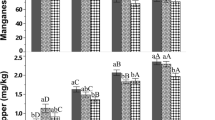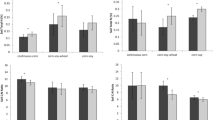Abstract
Efficient fertilizer use is a prerequisite for achieving optimum crop yield while avoiding environmental contamination. Cereal response to nitrogen (N), sulfur (S), and phosphorus (P) were determined for 6 years under differing tillage [conventional-till (CT) vs. no-till (NT)] and intensity of cropping (cereal/fallow vs. cereal/cereal). Semidwarf white winter wheat (Triticum aestivum L.) alternated yearly with either fallow or spring cereal [barley (Hordeum vulgare L.) or spring wheat] on a Typic Haploxeroll soil in a 415 mm rainfall zone. Fertilizer treatments were no fertilizer (None), N only (N), N plus S (NS), and N plus S plus P (NSP). Average application rate, when applied, was 109 kg N, 18 kg S, and 11 kg P ha−1. Average cereal yield without fertilizer was 1.82 t ha−1. Nitrogen increased grain yield in 6 of 6, S in 4 of 6, and P in 3 of 6 years, with P and S response significant the remaining years at the 10% probability level. Average yield increases were 1.11 t ha−1 for N, 0.93 t ha−1 for S, and 0.47 t ha−1 for P. The NT/CT yield ratio was 0.60, 0.75, 0.93, and 0.95 with None, N, NS, and NSP addition, respectively, indicating that N and S deficiency were more severe in no-till. Limited increase in the NT/CT ratio with P addition indicated that P deficiency was less affected by tillage. Winter wheat always yielded less under NT than CT regardless of fertility, whereas spring cereals reached equality when fertilized with NSP. Annually-cropped wheat yielded 52, 67, 89, and 90% of wheat after fallow with None, N, NS, and NSP, respectively. Thus N and S, but not P, deficiency was more intense with increased frequency of cropping. Adequate fertility was a prime prerequisite for efficient yield in all systems.
Similar content being viewed by others
References
Allison FE (1973) The role of soil organic matter in crop production. New York, Elsevier Sci Publ Co
Horneck DA, Hart JM, Topper K and Koepsell B (1989) Methods of soil analysis used in the soil testing laboratory at Oregon State University. SM89: 4, Corvallis, OR, Oregon Agric Exp Stn
Leggett GE (1959) Relationship between wheat yield, available moisture, and available nitrogen in eastern Washington dryland areas. Washington Agric Exp Stn Bull 609
Luebs RE and Laag AE (1969) Evapotranspiration and water stress of barley with increased nitrogen. Agron J 61: 921–924
Olson RA (1984) Nitrogen use in dryland farming under semiarid conditions. In Hauk RD, ed. Nitrogen in Crop Production, pp. 335–347, Madison, WI, ASA-CSSA-SSSA
Phillips RE, Blevins RL, Thomas GW, Frye WW and Phillips SH (1980) No tillage agriculture. Science 208: 1108–1113
Power JF (1990) Fertility management and nutrient cycling. In: Singh RP, Parr JF and Stewart BA (eds) Dryland Agriculture: Strategies for Sustainability, pp 131–150. Adv Soil Sci, Vol. 13. New York, Springer-Verlag
Ramig RE, Rasmussen PE, Allmaras RR and Smith CM (1975) Nitrogen-sulfur relations in soft white winter wheat. I. Yield response to fertilizer and residual sulfur. Agron J 67: 219–224
Randall GW, Wells KL and Hanway JJ (1985) Modern techniques in fertilizer application. In Engelstad OP (ed.) Fertilizer Technology and Use, pp 521–560, 3rd edn, Madison, WI, Soil Sci Soc Am
Rasmussen PE and Kresge PO (1986) Crop response to sulfur in the western United States. In: Tabatabai MA (ed) Sulfur in Agriculture, pp 357–375. Monogr 27. Madison, WI, American Society of Agronomy
Steel RDG and Torrie JG (1980) Principles and Procedures of Statistics, 2nd edn. New York, McGra-Hill Book Co
Viets FG Jr (1962) Fertilizers and the efficient use of water. Adv Agron 14: 223–264
Vitosh ML, Darlington WH, Rice CW and Christenson DR (1985) Fertilizer management for conservation tillage. In: D'Itri FM (ed) A Systems Approach to Conservation Tillage, pp 89–98. Chelsea, MI, Lewis Publ Inc
Author information
Authors and Affiliations
Rights and permissions
About this article
Cite this article
Rasmussen, P.E., Douglas, C.L. The influence of tillage and cropping-intensity on cereal response to nitrogen, sulfur, and phosphorus. Fertilizer Research 31, 15–19 (1992). https://doi.org/10.1007/BF01064223
Received:
Accepted:
Issue Date:
DOI: https://doi.org/10.1007/BF01064223




